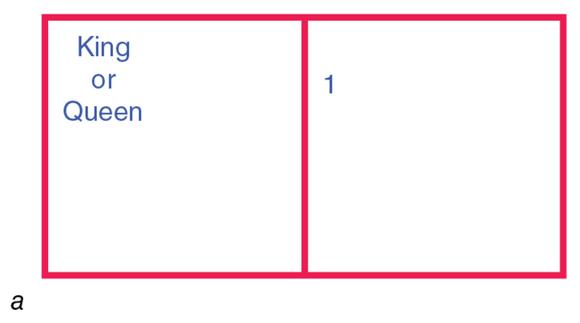Learn to play a game of Forearm Four Square
This is an excerpt from Physical Education for Homeschool, Classroom, and Recreation Settings by John Byl,Bettie VanGils Kloet.
Forearm Four Square
Objective
To advance to the king’s or queen’s court by successfully using a forearm pass into each other’s squares
Specific Skill Focus
Forearm pass (volleyball)
Equipment
One volleyball
Setup
- Draw a four-square box as shown in the figure, with each section approximately two steps square.
- Players stand in each of the squares; the player in the king or queen square holds the ball and begins play.

How to Play
- The queen (or king) tosses the ball up and does a forearm pass that goes higher than her waist and bounces on the ground inside one of her opponent’s squares.
- The player in whose square the ball lands must forearm pass the ball so that it goes higher than her waist and lands inside one of her opponent’s squares.
- If a player does not hit the ball high enough, or does not hit the ball inside one of her opponent’s squares, she is out.
- When a player is out, she goes to the number 1 square and everyone else moves up one square (in other words, if the player in number 2 makes an error, player 2 goes to the number 1 square and the player in the number 1 square goes to number 2; if the player in number 3 makes an error, then this player goes to the number 1 square, the player in the number 1 square goes to number 2, and the player in the number 2 square goes to number 3; if the king or queen is dethroned by making a mistake, that player goes to the number 1 square, the other players move up one square, and the player that was in number 3 becomes the new king or queen).
- The king or queen gets the ball and begins play again.
Variation
Four square can also be played with two or three players, with the court outlined as shown in the figures.


Questions for Understanding
- How can you most effectively get other players out?
- How can you control the direction of the ball with a forearm pass?
SHOP

Get the latest insights with regular newsletters, plus periodic product information and special insider offers.
JOIN NOW
Latest Posts
- Using double inclinometers to assess cervical flexion
- Trunk flexion manual muscle testing
- Using a goniometer to assess shoulder horizontal adduction
- Assessing shoulder flexion with manual muscle testing
- Sample mental health lesson plan of a skills-based approach
- Sample assessment worksheet for the skill of accessing valid and reliable resources


